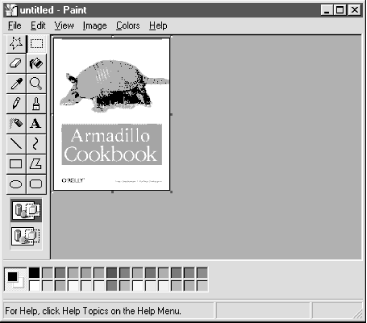8.4 Adding Additional Formats
| only for RuBoard - do not distribute or recompile |
8.4 Adding Additional Formats
Since it sounds so easy to add support for bitmaps, let's go ahead and do it. The first thing we want to do is add the bitmap format to the registry. The previous script already has the entry we need:
[HKEY_CLASSES_ROOT\CLSID\{5BE98B48-FD84-11D2-9FE5-00550076E06F}\DataFormats\GetSet] @ = "2,1,16,3" As stated earlier, these values correspond to < format , aspect , medium , direction >, in this case CF_BITMAP , DVASPEC
T_CONTENT , TYMED_GDI , and DATADIR_GET OR ed with DATADIR_SET .
Next, we need to modify QueryGetData in order to recognize the new format. When the shell asks if we can provide bitmaps, we need to be able to tell it "yes." Example 8.5 contains the modified version of the method.
Example 8.5. QueryGetData with Bitmap Format Added
Public Function QueryGetDataVB(ByVal this As IDataObject, _ pformatetc As FORMATETC) As Long QueryGetDataVB = DV_E_FORMATETC 'Text If (pformatetc.cfFormat And CF_TEXT) And _ (pformatetc.dwAspect = DVASPECT_CONTENT) And _ (pformatetc.TYMED = TYMED_HGLOBAL) Then QueryGetDataVB = S_OK End If 'Bitmap If (pformatetc.cfFormat And CF_BITMAP) And _ (pformatetc.dwAspect = DVASPECT_CONTENT) And _ (pformatetc.TYMED = TYMED_GDI) Then QueryGetDataVB = S_OK End If End Function
Good news: we don't have to do a thing with EnumFormatEtc . Everything there is already in place.
This leaves us with GetData . Since we are providing data in two formats now, it might be a good idea to clean up our implementation somewhat. We can move all of the code that deals with the text format into a Private method called GetText . All the code for bitmaps can go into GetBitmap . Now our GetData implementation, which is shown in Example 8.6, is a little more streamlined. We can now add formats without getting in the way of the implementation.
Example 8.6. GetData with Bitmap Support
Public Function GetDataVB(ByVal this As IDataObject, _ pformatetcIn As FORMATETC, _ pmedium As STGMEDIUM) As Long GetDataVB = DV_E_FORMATETC If (pformatetcIn.cfFormat And CF_TEXT) And _ (pformatetcIn.dwAspect = DVASPECT_CONTENT) And _ (pformatetcIn.TYMED = TYMED_HGLOBAL) Then GetDataVB = GetText(this, pmedium) End If If (pformatetcIn.cfFormat And CF_BITMAP) And _ (pformatetcIn.dwAspect = DVASPECT_CONTENT) And _ (pformatetcIn.TYMED = TYMED_GDI) Then GetDataVB = GetBitmap(this, pmedium) End If End Function
Of course, now we have to actually provide the data for both of our formats. We'll look at GetText first (see Example 8.7), simply because it makes the chapter more suspenseful that way. Anyway, we have already discussed this code. There is nothing new, other than the fact that its implementation has been moved outside of GetData .
Example 8.7. GetText
Private Function GetText(ByVal pDataObject As IDataObject, _ pmedium As STGMEDIUM) As Long GetText = DV_E_FORMATETC Dim b( ) As Byte Dim dataObj As clsDataHandler Dim hGlobalMem As HGLOBAL Dim pGlobalMem As Long Dim szType As String Dim szMsg As String Set dataObj = pDataObject 'Get Animal type. szType = Space(255) GetPrivateProfileString "Animal", _ "Type", _ "Unknown", _ szType, _ Len(szType), _ dataObj.FileName 'Allocate global memory. hGlobalMem = GlobalAlloc(GMEM_MOVEABLE, 1024) 'Get a pointer to the global memory. pGlobalMem = GlobalLock(hGlobalMem) 'Copy Animal type into global memory. szType = TrimNull(szType) szMsg = "The " & szType & " is on the clipboard." & vbCrLf b = StrConv(szMsg, vbFromUnicode) & vbNullChar CopyMemory ByVal pGlobalMem, b(0), UBound(b) + 1 'Unlock global memory. GlobalUnlock hGlobalMem pmedium.pData = hGlobalMem pmedium.TYMED = TYMED_HGLOBAL Set pmedium.pUnkForRelease = pDataObject Set dataObj = Nothing GetText = S_OK End Function
Now, the moment we have all been waiting for. Inside of the resource file that contains the icons for our icon handler (Chapter 5) and the dialog for our property sheet extension (Chapter 6), there are five bitmaps. These bitmaps are all pictures of O'Reilly books that have animals on the cover matching our .rad file animal types. The resource identifiers are defined like so:
Private Const IDB_ARMADILLO = 101 Private Const IDB_CAT = 102 Private Const IDB_COW = 103 Private Const IDB_DOG = 104 Private Const IDB_FISH = 105
Now that you have this bit of background information, we can look at the GetBitmap function. Don't get excited, though. The function is so simple it's almost anti-climatic. Example 8.8 contains the listing.
Example 8.8. GetBitmap
Private Declare Function LoadBitmap Lib "user32" Alias _ "LoadBitmapA" (ByVal hInstance As Long, _ ByVal lpBitmapName As Long) As Long Private Function GetBitmap(ByVal pDataObject As IDataObject, _ pmedium As STGMEDIUM) As Long GetPicture = DV_E_FORMATETC Dim dataObj As clsDataHandler Dim szType As String Dim lBitmap As Long Set dataObj = pDataObject 'Get Animal type. szType = Space(255) GetPrivateProfileString "Animal", _ "Type", _ "Unknown", _ szType, _ Len(szType), _ dataObj.FileName szType = TrimNull(szType) Select Case UCase$(szType) Case "ARMADILLO" lBitmap = IDB_ARMADILLO Case "CAT" lBitmap = IDB_CAT Case "COW" lBitmap = IDB_COW Case "DOG" lBitmap = IDB_DOG Case "FISH" lBitmap = IDB_FISH Case Else Exit Function End Select pmedium.pData = LoadBitmap(App.hInstance, lBitmap) pmedium.tymed = TYMED_GDI Set pmedium.pUnkForRelease = pDataObject Set dataObj = Nothing GetPicture = S_OK End Function
GetBitmap 's first duty is to retrieve a reference back to our data object and get the name of the .rad file that has just been copied . Then, based on the type of animal, the local variable lBitmap is assigned to one of the resource identifiers representing the picture of an animal.
Providing the bitmap to the shell is as simple as calling LoadBitmap with the resource identifier of the animal that we want.
|
Lastly, the tymed member of the STGMEDIUM structure needs to be set to TYMED_GDI in order to inform the shell that the data is a GDI componentin other words, a handle to a bitmap.
Now, we have two formats available for one copy operation. The original text string will be available to any program that can handle CF_TEXT data, and, as Figure 8.4 illustrates, programs that can manipulate CF_BITMAP data are provided for as well.
Figure 8.4. Armadillo data in CF_BITMAP format

| only for RuBoard - do not distribute or recompile |
EAN: N/A
Pages: 128
